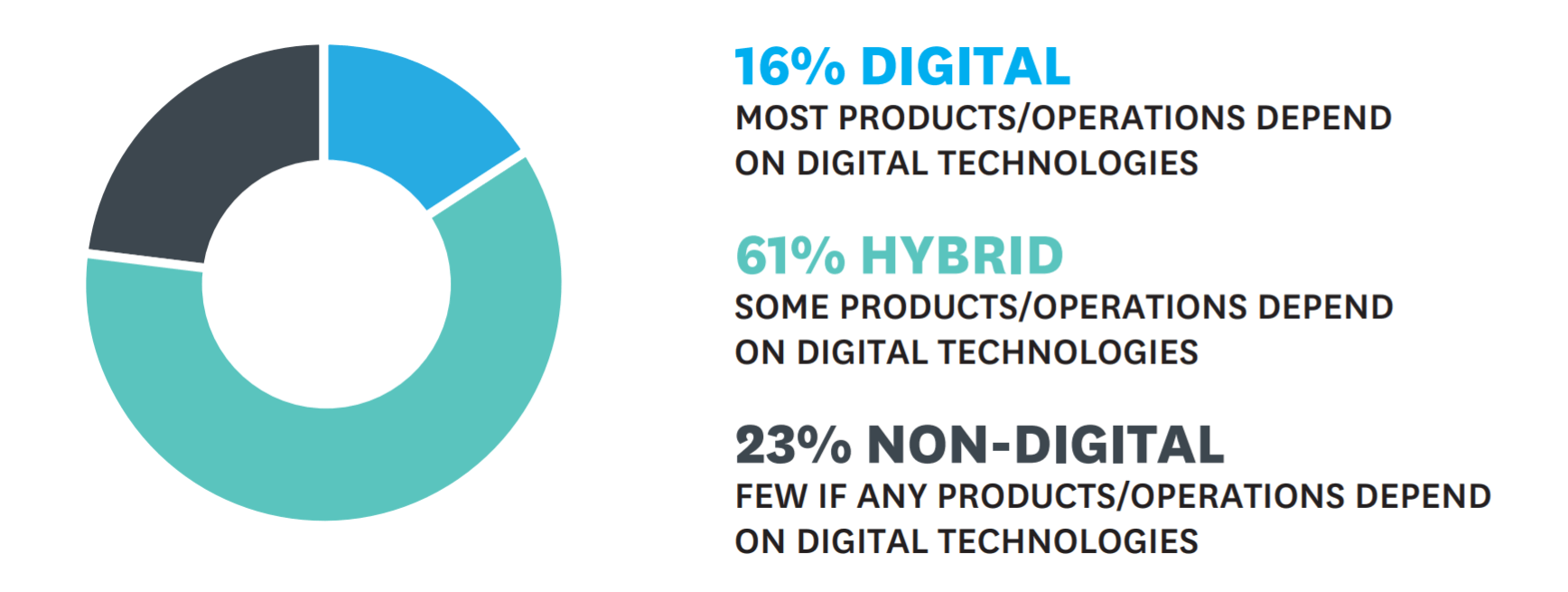Why digital transformation strategy matters?
Among other, well-thought-out digital transformation strategy can bring the following benefits:
- Improved operational resilience. Digital transformation is not always about adopting new technologies; it’s often about shedding outdated processes and legacy systems. It enables a company to optimise processes, become more flexible, and rise to new challenges and market disruptions, leveraging digital technologies as key enablers.
- Better customer experience. According to McKinsey, digital transformation can increase customer satisfaction rate by 20-30%, resulting in 20-50% of economic gains. Developing a good transformation strategy will help focus on customers and provide vital services and features to enhance the overall experience.
- Increase in revenue. Implementing digital transformation can open new markets, ample opportunities and bring higher profitability. Gartner's CIO Survey of nearly 2,000 CIOs shows top-performing enterprises are prioritizing digital transformation during the pandemic.
Businesses can begin digital transformation for multiple reasons, and to make it right, they need a successful strategy. The global shift towards digital operations — such as low-touch economy minimising physical interactions, cashless payments, hyperautomation and other trends accelerated by the pandemic — indicates that keeping with the pace of changes is more than just reaping benefits; it’s already an existential issue for a company.
How to develop an effective digital transformation strategy?
For over 29 years, we have been working as a software technology partner for enterprises across industries, including finance, retail, agriculture, logistics and more. We have worked on digital transformation projects for organisations large and small. Our definition of digital transformation is this: a complete overhaul of an enterprise and its technological foundations, end-to-end.
Digital transformation covers enterprise products and services right through to operations and workflow. With hundreds of projects behind us we have found that the following five building blocks are essential to building a successful digital transformation strategy:
1. Focus on the objectives and impact

Latest technology trends are frequently the kick-off point for digital transformation, and it is easy to fall into the trap of starting the transformation in response to a trend without knowing what the end goal is. Doing so can lead to sporadic changes that become chaotic. In turn, these changes do not integrate well because there is no strategic outlook. Maintaining customer and business value throughout digital transformation is key.
A digital transformation that is not co-ordinated can put enterprises at risk of losing existing customers, eroding once lucrative markets. Another common issue is that those in charge of digital transformation often have a big-picture view of the organisation that may jar with what happens in reality daily. To avoid this situation, enterprises must plan, design and test from operations and customer perspective, building an understanding of where business value lies.
Such tools as Business Model Canvas can provide insight into where the real payoffs of business transformation lie. Consider the Zachman Framework, which assists in understanding enterprise relationships and dependencies through the mapping of enterprise architecture. Overall, meaningful changes should not be made without fully comprehending the organisational context and the enterprise architecture.
2. Provision of tech resources and funding
Digital transformation on an enterprise scale almost always involves capital and technology-intensive investments. It is not uncommon for promising transformation projects to stall mid-way because of a lack of funds or due to technology infrastructure that cannot cope with increased demands.
Starting a budgeting process right at the inception of a digital transformation project is essential to ensure that the scope of a project does not grow beyond the capabilities of an enterprise to fund it. A realistic budgeting and funding approach is crucial because a stalled transformation project brings little value.
A discovery phase that can create a clear vision of the departure point regarding an organisation’s digital maturity is a good start. Technology leaders should ensure that a solid technology foundation exists before embarking on digital transformation. Consider hiring experienced technology architects to ensure a vendor-independent architecture is put into place, centred around user value.
3. Engage stakeholders, assign ownership
The implications of digital transformation reach wide and deep, and its success depends on buy-in from stakeholders while those driving transformation should take ownership of the project. Success depends, for example, on the involvement of team members at both the executive level and board level. Leaving either out can lead to a transformation project, getting stuck in a loop of approval and adjustment.
Executive teams should involve board members throughout while simultaneously bringing in every stakeholder. The motivational aspect is also key to successful digital transformation, and this is why creating buy-in is so important. In large enterprises, digital transformation will require project advocates at every level of seniority and in every department.
4. Set milestones, draw up a roadmap
Problems can arise if digital transformation is embarked upon without sufficient planning. Transformation can fail without the right planning and strategic vision, especially if the scope and reach of digital transformation aren’t crisply defined. Deliverables can quickly spiral out of control if they are not fully described.
An ad-hoc digital transformation process can be abrupt and lead to internal resistance because:
- The pace of change is too fast for the business and does not align with the organisational culture.
- Changes and expectations are not sufficiently explained and managed.
- Milestones are not defined, and highly motivational quick wins are never made.
The issues just listed are rarely intentional; rather these come to the fore due to a lack of competence and insufficient planning. Steps to fix these problems include:
- Starting with a plan before taking any action and include milestones, outlining every small step along the way
- Including quick wins that can boost motivation for everyone involved, from developers through to staff and stakeholders
- Ensuring everyone understands the why and how of the changes, across the company.

5. Ensure sufficient resources and expertise
Finally, digital transformation always requires a dedicated team. Set up a sufficiently resourced internal executive team that has the necessary knowledge and the authority to make decisions. While software development and integration can be outsourced to a technology partner, your internal staff must be ready to manage and drive the project.
Experienced digital transformation partners can start by doing an overview of your enterprise architecture through interviews with executive teams. Doing so can allow a technology firm to build an understanding of your organisation and its environment, leading to a context analysis that highlights pain points and areas where digital transformation can be of real benefit.
A technology partner can often deliver a more in-depth, less biased analysis and can come to a closer picture of how an enterprise functions. Obtain a clear picture of the status quo to start off with and the end goals of your digital transformation project are easier to formulate, and clearer in their own right.
Conclusion
In short, successful move to digital requires understanding that this process is a long road that requires a thoroughly considered digital transformation strategy with clear milestones. Mature enterprises cannot be overhauled in an instant. It is vital to understand enterprises change slowly and that embracing digital transformation in an unrushed manner is vital.
With over 27 years of experience executing, overseeing and advising on software engineering projects, we have the insight to help your enterprise get the most of what today’s technology offers. Let’s discuss your challenges, goals and objectives. We’ll be happy to hear from you. Get in touch!
Related Insights


















